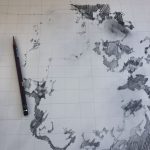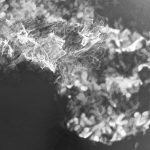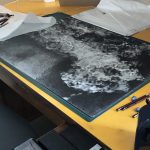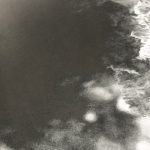Talking with João is one of my favorite things to do. We like to talk about the nuts and bolts of our universe—its mechanics, such as how stellar dust gathers into clouds and collapses into sheets, which break into filaments that seed the birth of stars. As we talk about the granular, sometimes, too, the ineffable slips in.
A few years ago, João sent me an image of a previously unrecognized, giant molecular cloud. The calibrated dust emission map is a high-resolution image stitched together with a low-resolution image, combining information from two telescopes. João and I had been talking about not just what we see, as a scientist and an artist, but how we see (which is equally informative). Here was that idea’s perfect embodiment: the disjuncture between the two sets of information a constant reminder of the numerous techniques of seeing, and the ways in which they can both expand and limit observation.
During the confusing newness of the pandemic, and a time of social isolation, I began to draw the image. I trusted the process of sitting with this image, enacting its translation, would lead me somewhere. I often wrote to João as a way to work through what I was thinking, what I was doing, what I was making. In an email dated December 8, 2020, I wrote to João about darkness. I wrote about how when we sit in (or with) darkness, we learn to see in different ways, and from those new ways of seeing we’re able to produce something that emerges from the darkness. I wrote to João how it might seem that in science, and in our lives, we would ideally see more clearly. But in this map of dust, João agreed that different advantages are gained with the two levels of resolution: one, an overall perspective, the other a focused understanding. And when translated into a drawing, these two resolutions had their own structure, their own individual eloquent beauty, that needed to be drawn in different technical ways. One was achieved by taking an old cotton shirt to blur my pencil marks; the other by carefully picking away with an eraser to bring out the highlights. Another outcome of the transposition: for the astrophysicist, capturing the blackness of space doesn’t necessarily produce much useful information, but for the draftsperson, blackness on the page is actually quite hard to produce. Graphite can be poured onto paper with layer after layer of pencil strokes, but that only burnishes the paper, creating a sheen. At one angle it reads as utter depth; at another angle it reads as a glossy shine. Black becomes dynamic.
Once finished, the drawing sat in a drawer for a year. I put it away because I wasn’t sure where it had taken me. As I wrote to João on March 30, 2021, perhaps the drawing’s job had simply been to keep me company. But when I pulled the drawing out a year later, I could see how perfectly it held our conversations. In one of João’s early emails to me, he acknowledged how all of us “are eternally dealing with complexity,” yet only digesting tiny portions at a time, “avoiding most of it because it’s all too rich, too beautiful.” I am grateful for this richness, these conversations, these ways of seeing.











